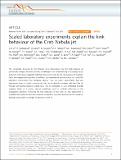Scaled laboratory experiments explain the kink behaviour of the Crab Nebula jet
Author(s)
Tzeferacos, P.; Lamb, D.; Gregori, G.; Norreys, P. A.; Follett, R. K.; Froula, D. H.; Koenig, M.; Amendt, P. A.; Park, H. S.; Remington, B. A.; Ryutov, D. D.; Wilks, S. C.; Betti, R.; Frank, A.; Hu, S. X.; Sangster, T. C.; Hartigan, P.; Drake, R. P.; Kuranz, C. C.; Lebedev, S. V.; Woolsey, N. C.; Li, Chikang; Rosenberg, Michael Jonathan; Frenje, Johan A; Rinderknecht, Hans George; Sio, Hong Weng; Zylstra, Alex Bennett; Petrasso, Richard D; Seguin, Fredrick Hampton; ... Show more Show less
DownloadScaled laboratory.pdf (1.750Mb)
PUBLISHER_CC
Publisher with Creative Commons License
Creative Commons Attribution
Terms of use
Metadata
Show full item recordAbstract
The remarkable discovery by the Chandra X-ray observatory that the Crab nebula’s jet periodically changes direction provides a challenge to our understanding of astrophysical jet dynamics. It has been suggested that this phenomenon may be the consequence of magnetic fields and magnetohydrodynamic instabilities, but experimental demonstration in a controlled laboratory environment has remained elusive. Here we report experiments that use high-power lasers to create a plasma jet that can be directly compared with the Crab jet through well-defined physical scaling laws. The jet generates its own embedded toroidal magnetic fields; as it moves, plasma instabilities result in multiple deflections of the
propagation direction, mimicking the kink behaviour of the Crab jet. The experiment is modelled with three-dimensional numerical simulations that show exactly how the instability develops and results in changes of direction of the jet.
Date issued
2016-10Department
Massachusetts Institute of Technology. Department of Physics; Massachusetts Institute of Technology. Plasma Science and Fusion CenterJournal
Nature Communications
Publisher
Nature Publishing Group
Citation
Li, C. K. et al. “Scaled Laboratory Experiments Explain the Kink Behaviour of the Crab Nebula Jet.” Nature Communications 7 (2016): 13081.
Version: Final published version
ISSN
2041-1723